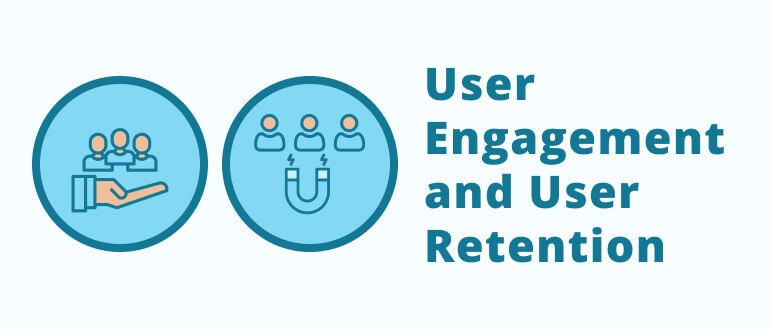So your mobile application is developed and launched, the target audience is engaged, and some are actively installing the product on their smartphones. Is it a success? Not yet. Until you convince users to open the app and interact regularly, the goal is not complete.
As the first quarter of 2020 ended, Google Play had accumulated over 2,56 billion apps, and the App Store – 1,85 billion. However, a smaller number of products are not only installed but used frequently. Look at your smartphone: how many apps do you open at least once a month or once a week? And how many app abandonments exist after just one engagement or no use at all? Your target audience has the same situation. They have no time for a ton of new apps, so they stick to a chosen few. The goal for any new product is to be among those that are chosen.
Based on Quettra's data, we see the average app loses 77% of active users within the first 3 days after upload and 90% within 30 days. At the same time, companies annual loss from product disconnections is close to $1.6 trillion.
User acquisition is 25 times more expensive than retaining an existing one. From the first time an app is opened, you should offer the best user experience possible. Revisiting of apps should be a priority for any business that plans a return on investment and long-term profits. For this reason, the first task of a professional mobile app development company is to increase the level of user retention and user engagement engaging various methods. These can be push notifications, social integration, tool prep for email marketing, permanent improvement of user experience, etc.
Definition of User Engagement and User Retention

The mobile app industry is relatively young, but developing rapidly. It is estimated to bring in $935 billion through paid app downloads and in-app advertisements by 2023. This is a key figure for businesses to consider so they can avoid adding to remote or lost smartphone programs.
The main indicators for any successful app are user retention and engagement. Based on Statista’s data, only 32% of people will use a new product more than 11 times after download, and 25% will only use it once. Today, marketers and developers must work at max capacity to ensure their mobile app stands out among competitors.
Retention is considered an index showing the number of users who return to the app after the initial download. However, it's better to consider what actions a business should take to achieve this value. In other words, this set of initiatives aims for constant use of the application and a reduced app abandonment rate.
A Harvard Business School study showed that increasing user retention rates by 5% increases profits by 25-95%. Apps with a successful strategy for stimulating interaction are more valuable to clients, long-term. By using small incentives, like customized birthday cards or promo code offers, users feel personally connected to the product and are more likely to return.
The percentage of client retention directly depends on their degree of involvement, which shows how active users are in your app. In this case, we’re speaking of not only numbers but also the quality of interactions. Regular customers using the product on a needs basis (for example, Uber) are more valuable than those who open it often but show zero results.
To develop interesting solutions for mobile app users, you should step back and look at the main reasons why people use mobile apps:
- Problem-solving or overcoming inconvenience. This reason is related to the main values of any product – to make the client's life easier. At the stage of idea development, sufficient attention should be paid to each function and how it will solve specific problems.
- Integration of different devices. The ability to use an app on computers, tablets, and smartphones, while securing personal data, can be one of the most competitive advantages.
- Attractive design and aesthetics. You might agree there are applications you pick from hundreds of others because the navigation is convenient, pages and in-app themes are beautiful, and it’s easy to use overall. Competitors can be more functional, but app design is the defining element.
- Regular content updates. Products that often add or reveal new useful information to the user rarely end up in the “wastebasket.”
Consider how you can use this knowledge to increase user engagement for your future solution. An app’s main value for customers is their interaction with it and the benefits they receive, which results in potential profit for you. Show your users why the mobile app you’re offering is a reliable solution to their problems, now and in the future.
Wondering how to build
an exclusive software product for your business?
CONTACT USWays to Re-engage and Retain App Users

You’re doing a great job of attracting users who want to download your mobile app. However, it requires more effort to retain the target audience and turn them into regular customers who recommend your product to friends.
Now that we’ve mentioned the obvious benefits of user retention and engagement let’s consider several interactions that strengthen the chances of a long-term relationship.
Push Notifications

Notifications that are implemented correctly can increase a customer's retention rate by 20%. Even more, personalized notifications can multiply the mobile app’s duration term by seven times. What’s the secret? Users want to receive relevant notifications that offer direct and personal value. Besides, nobody likes spam in any form.
Balance is also important. If users get too many irrelevant notifications from the app, they are likely to turn off notifications or delete the program altogether. However, mailing at random intervals is not a good strategy. You need to research to determine an appropriate mailing frequency.
For example, if a user has been inactive, push notifications can remind them about products, encourage them to try it by sharing achievements from others, or by offering time-sensitive discounts.
Social Media Channels

Apptentive’s research shows that 79% of users check ratings and reviews before deciding to upload an app. And, surprisingly, more people look for information on social media than Google. This is why it’s essential to offer rewards or incentives for users who share recommendations and evaluations with others. Gamers, for instance, can publish screenshots of their records and achievements.
Such simple strategies are essential to both players and app owners. These types of publications serve as native advertising for the product while bringing more downloads. Even more, this approach is one of the cheapest ways to obtain app user acquisition.
The developer's task is to provide easy social network integration options so that users can exchange information in one click.
Email Re-Engagement strategy

Emailing is often underestimated. However, in almost any app, users leave their email addresses during registration. Such a powerful tool for client contact, especially in a competitive environment, should be used immediately in the customer retention strategy.
A well-designed and implemented action plan can bring long-lost users back to your app and encourage those who rarely use it to open it more frequently. When emailing, it is important to use only verified services to ensure your letters are delivered to the recipient’s inbox and not junk folders.
The email offer shouldn’t look like spam. It should be well-designed, personalized, and contain useful information. For example, you can state special terms, reveal new products to motivate purchases, or create engaging themed messages like «We miss you!». Of course, keep in mind what is most appropriate for your audience.
Wondering how to build
an exclusive software product for your business?
CONTACT USApp UI/UX Improvements

There is no ideal app. All apps must improve user experience annually. Today, it is vital to not only keep up with trends of mobile apps but also initiate them. Continual improvement of the UI/UX design is one of the main conditions for any product’s existence.
Data from the latest app UX/UI modifications and corrected app bugs appear in the App Store and Google Play. If the related information is outdated, users will assume the program is invalid and choose a competitor. It is essential to show both existing and potential customers you care about their interactive experiences by releasing new app versions.
Product changes should be the result of your own analysis and user feedback. By eliminating difficulties that stand in the way of achieving targeted actions, such as fixing app performance, you can increase customer engagement and retention. These type improvements will also bring more loyalty and satisfaction as you offer the best product to your users with the latest app trends.
Conclusion
Caring about user engagement and retention differentiates a successful app from a failed one. Both factors are closely related to providing users with value through the product. If you can solve their problems, make their lives easier, and do it with kindness, customers will definitely return to the app year after year.
Turning users into regular customers increase your business income and ensure its existence. Therefore, you need to thoroughly approach the strategy of target audience retention, beginning with a professional development team's choice.
Owlab’s experts have considerable experience in creating highly competitive apps and launching them in the market. We understand there are no insignificant details when it comes to development, so we pay serious attention to all seemingly small aspects of the future product. That is why we create modern applications that are exceptionally functional, easily modified and scaled, and profitable.
Contact us for a consultation and start your new project today!